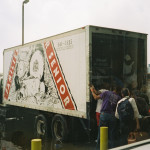
Sometimes vacations don’t go quite go as planned — or a lot worse.
Just ask Paul Harris. Ten years ago this past August, the then-San Diego resident bought a plane ticket to New Orleans “just because it’s one of my favorite cities in the U.S. to visit. It has the food, the architecture, the history, the music, the wacky personalities, the party life. Oh, and did I mention the food?”
Harris, who now lives in Cathedral City, thought that when he arrived in New Orleans his visit would be much like the half-dozen he’d made through the years. It was Friday, Aug. 27, 2005, and Harris was soon to remember this trip as his most memorable.

The next day, talk of Hurricane Katrina hitting the city was monopolizing the news, Harris remembers, and “(my hotel) told us we had to find other places to stay because they weren’t going to be open because of the hurricane.
On Sunday, I walked to another hotel, but (the then-mayor) Ray Nagin issued an evacuation order for the city, so I called a cab.”
Unfortunately, the airport had shut down, so Harris went to the bus station, but it, too, was closed.
“I had to make the decision to stay or attempt to evacuate.”
The latter was difficult to do since he had no transportation, and hitchhiking in what he called a “sketchy neighborhood” didn’t seem like an option either.

A policeman told him that the Superdome would be open for those who couldn’t leave the city.
“I went and got some money out of an ATM and bought as much snack food as I could,” Harris said. “Then I went to the Superdome. I was one of the first 500 people in line.”
The stadium — home field of the New Orleans Saints — was his home for the next three days.
“I immediately found a spot at the 50-yard line,” Harris said. “I figured I’d never get those seats again.”
Everyone who entered the Superdome was “frisked pretty thoroughly,” by the National Guard and were required to place any drugs, alcohol and firearms into a barrel.
While conditions were tolerable at first — there were MREs (meals ready to eat; used by the military) and bottled water — these eventually dwindled and rationing was necessary. Then the lights went out and running water ceased to flow. Those taking care of sick people could go to the head of the food line, but had to return for themselves, often waiting up to three hours.

“I had no idea that it would get so bad,” Harris said. “People were getting scared and nervous. The bathrooms were dark. You just had to go in an overflowing toilet. There was no air-conditioning and it was 90 degrees with high humidity. It was like living inside a Porta Potty. I’m shocked there weren’t more medical deaths.”

There were occasional fights and rumors of rape among the 25,000 inhabitants, but that’s what they were — only rumors.
“There was no black man who raped a 7-year-old girl or a white man who raped two black girls,” Harris said, referring to the rumors.
It was true, though, that one man committed suicide by jumping off a ledge.
“I heard the thud, but I never saw him,” Harris said.
After three days of camping in the Superdome, with the help of a National Guardsman, Harris and about 100 other tourists walked to the nearby sports arena. From there they were transported by truck to the Hyatt Hotel, where the mayor and the press were stationed.
“There wasn’t water or electricity there either, but it wasn’t so crowded,” Harris said.

Finally, a week after his arrival in New Orleans, Harris was able to take a bus to Dallas.
“It’s an experience I’ll never forget,” he said. “I learned a lot about human behavior — how powerful fear is as an emotion, and that most people are good and want to help each other. I also learned that, in a disaster, someone needs to be clearly in charge and accurate information has to be given out.”
Harris’ e-book about his experience, “Diary From the Dome: Reflections on Fear and Privilege During Katrina,” is available on Amazon for $4.99.
Twenty percent of proceeds go to New Orleans charities such as Habitat for Humanity.
E’Louise Ondash is a freelance writer living in North County. Tell her about your travels at [email protected]


3 comments
Thank you, Jolie, and Sandy. If folks want to learn more about other truths behind the destruction in New Orleans please check out http://levees.org and support this fantastic organization.
Thank you Paul for your years of bringing the truth to light to all the falsehoods people tried to spread about Hurricane Katrina. Doctorju
Thank you for sharing your story. Hopefully, this was the last time an entire city has nearly zero communication for 5 days.
Comments are closed.